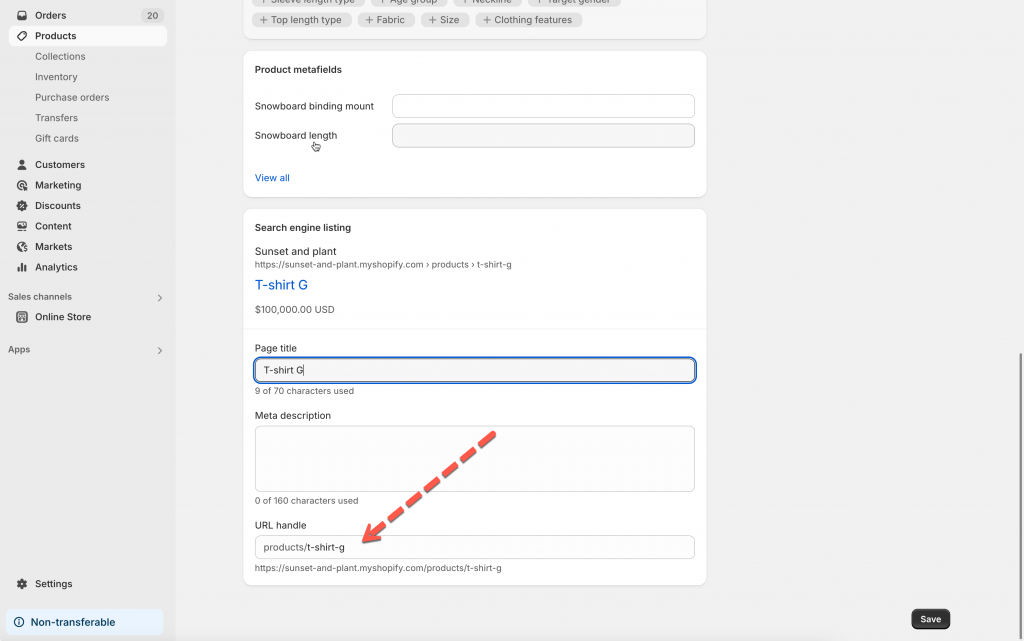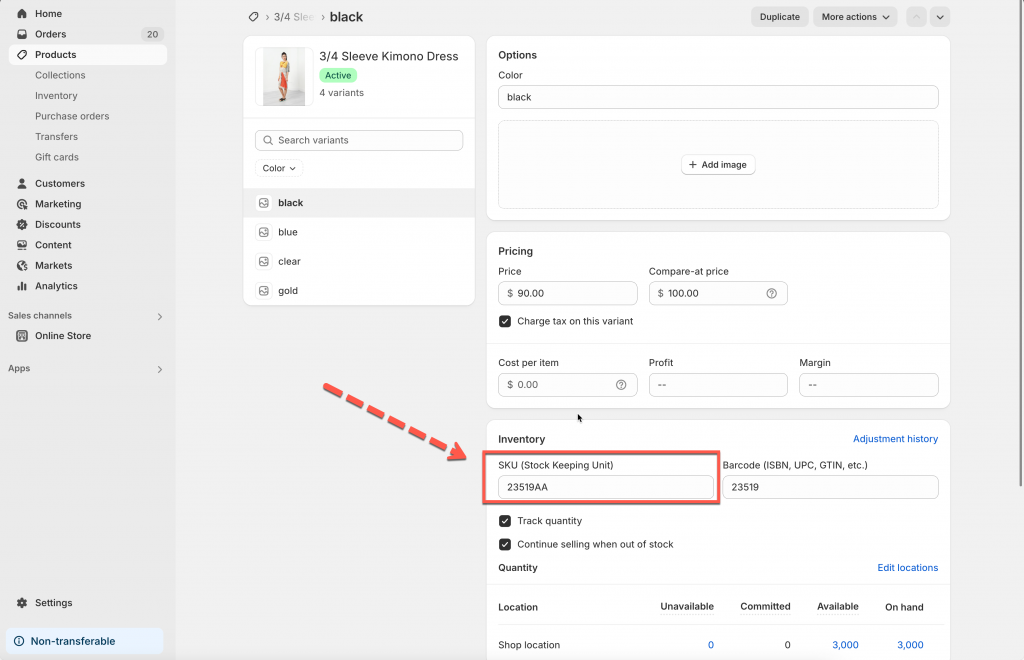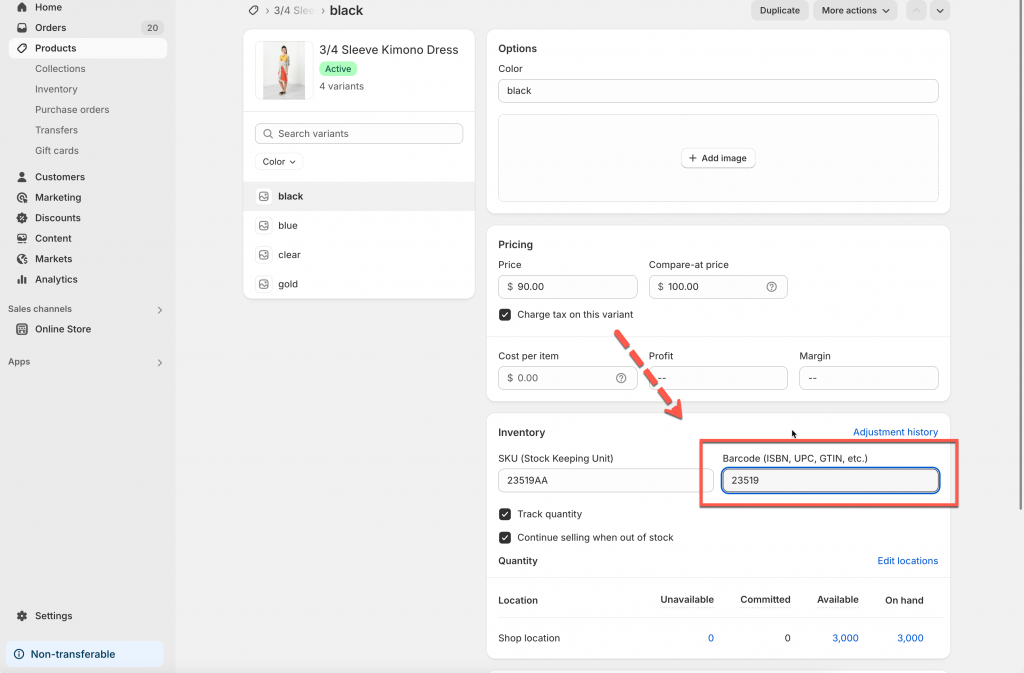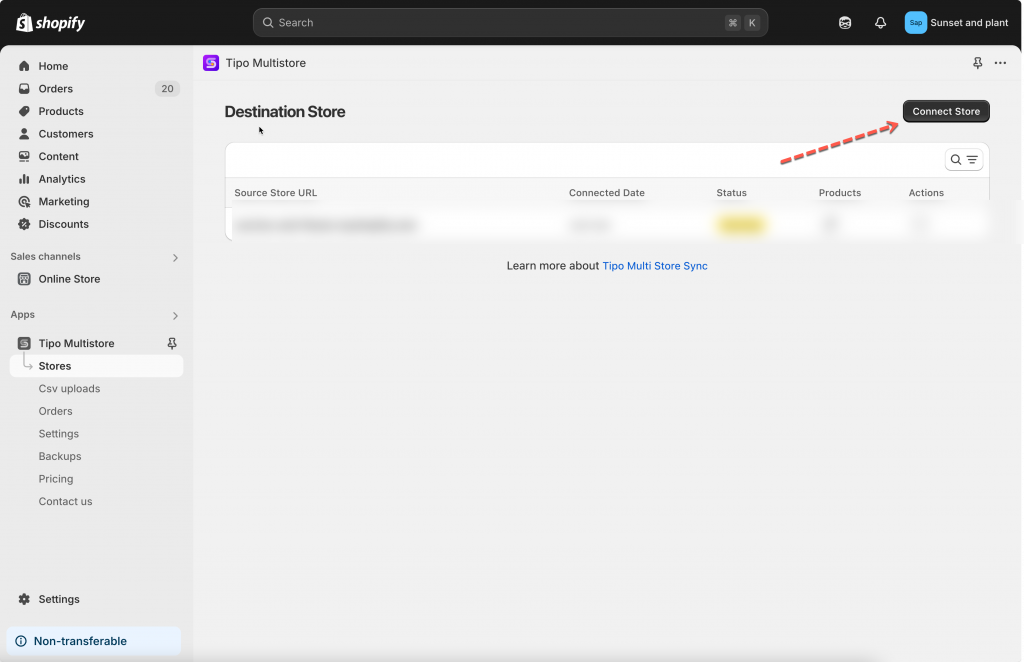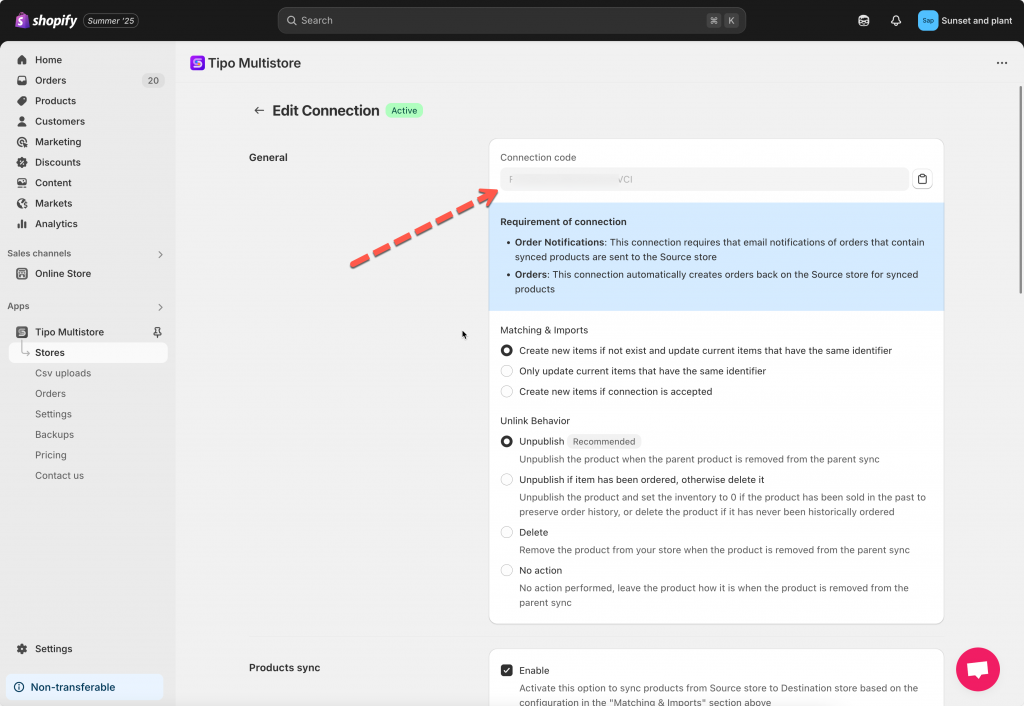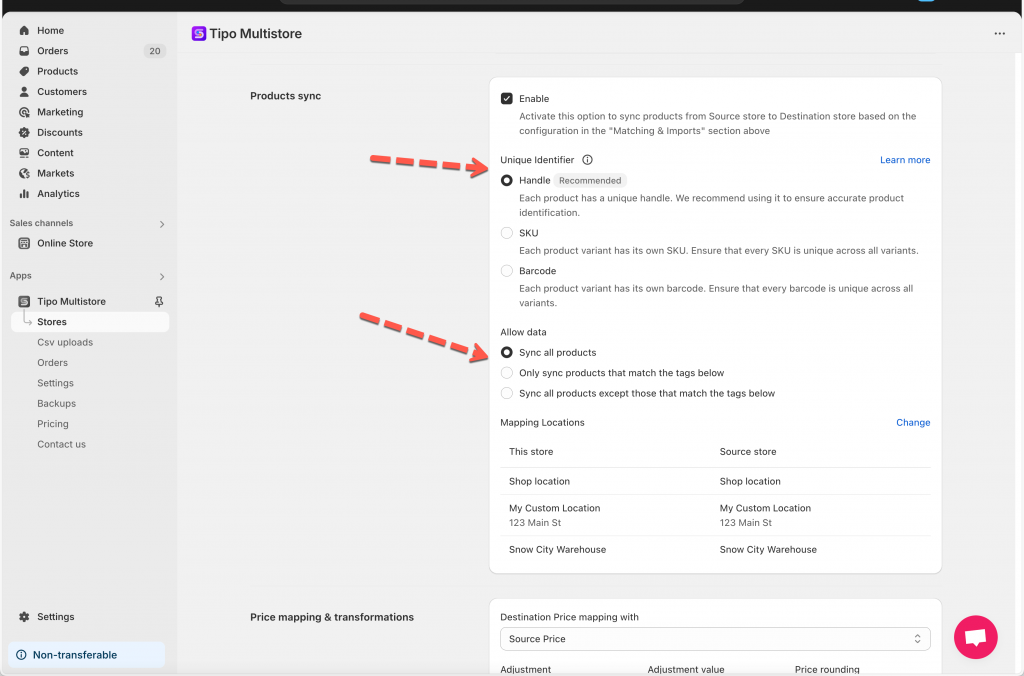Supported Identifiers
When syncing products between stores, it’s important to define how the app should match products. Our app supports mapping by three unique identifiers: product Handle, Variant SKU,
Variant Barcode
1. Product Handle (Recommended)
-
Definition: A unique, URL-friendly name assigned to each product in Shopify.
-
Example: A product titled “Red T-shirt” might have a handle like
red-t-shirt. -
Advantages:
-
Automatically generated and unique per product.
-
Stable and consistent, making it ideal for synchronization.
-
-
Where to Find:
-
In Shopify Admin: Navigate to Products > Select a product > Scroll to Search engine listing preview > Click Edit website SEO > The handle appears in the URL and handle field.
-
Alternatively, visit the product’s page on your storefront; the handle is the part of the URL after
/products/.
-
2. SKU
-
Definition: Stock Keeping Unit (SKU) is an alphanumeric code assigned to each product variant.
-
Example: A red, size M T-shirt might have an SKU like 23519AA.
-
Advantages: Useful for inventory management and tracking.
-
Important Note: SKUs must be unique across all variants. Duplicate SKUs can lead to synchronization conflicts.
-
Where to Find: In Shopify Admin: Navigate to Products > Select a product > Scroll to the Variants section > Each variant’s SKU is listed there.
3. Barcode
-
Definition: Barcodes are unique identifiers, such as UPCs or EANs, assigned to product variants.
-
Example: A barcode like 123456789012 might be assigned to a specific variant.
-
Advantages: Essential for physical inventory tracking and point-of-sale systems.
-
Important Note:: Barcodes must be unique across all variants. Duplicate barcodes can cause synchronization errors.
-
Where to Find: In Shopify Admin: Navigate to Products > Select a product > Scroll to the Variants section > Each variant’s barcode is listed there.
Steps to manage
1. Open the app in Source store > click Stores > click Get connect code button > copy the connect code on the popup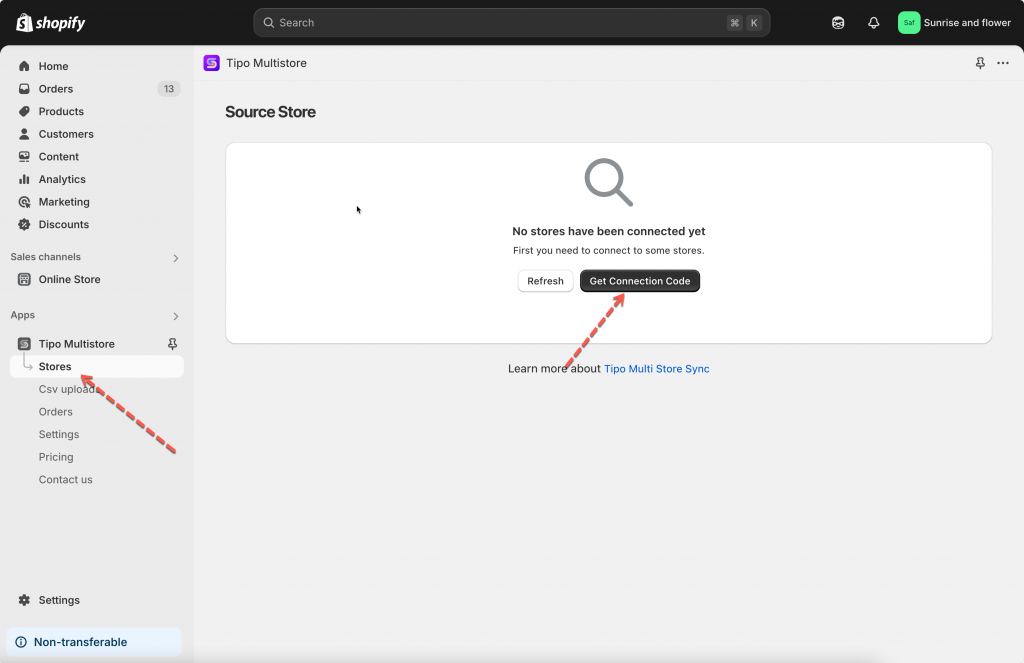
2. Go to the Destination store open the Tipo Multi-store app > click Stores > click Connect Store button
3. > Enter the connect key from source store > enable Product syncs option
4. Select a unique identifiers to sync products based on it. Our app supports mapping by three unique identifiers:
- Product Handle (Recommended): The product handle is a unique text identifier for each product. It’s the most consistent method for matching products across stores and is recommended for most cases.
- Variant SKU: Each product variant may have a Stock Keeping Unit (SKU). If you choose this option, make sure all SKUs are unique across your entire product catalog to avoid mapping issues.
- Variant Barcode: Barcodes are also used at the variant level. Like SKUs, barcodes must be unique across all variants. Duplicate barcodes can cause sync errors or conflicts
5. Select the products you want to sync
5 Click Save > the sync will be run immediately. It may take for while to complete.
Product Sync Priority
When syncing products between stores, our app uses a priority system to determine how variants are matched. This ensures accurate mapping, even if some data is missing or duplicated.
The priority order depends on the unique identifier you choose when connecting your stores:
| Selected Identifier | Matching Priority Order |
|---|---|
| Handle | SKU → Barcode → Variant Title |
| SKU | SKU → Barcode → Variant Title |
| Barcode | Barcode → SKU → Variant Title |
Note: If you choose Barcode as the identifier, it will now be prioritized first, followed by SKU and Variant Title. This ensures that the selected identifier is always used as the primary mapping key.
How the sync work based on the selected identifiers?
-
Products in the destination store with matching identifiers will be updated.
-
If no matching identifier is found, a new product may be created.
-
If duplicate identifiers exist, synchronization errors or mismatches may occur.
Note: A single product can have multiple variants, each with its own unique SKU or barcode. When mapping by SKU or barcode, the app needs to check each variant individually, which may take more time compared to mapping by product handle.
Examples by Identifier
Sync by Product Handle (Recommended)
Scenario: You have a product on both the source and destination stores with the same handle.
- Source store:
Product Name: Classic Blue Shirt
Handle: classic-blue-shirt
SKU: CLS-BLU-S
Barcode: 12345678 - Destination store:
Product Name: Blue Shirt
Handle: classic-blue-shirt
SKU: SHIRT-BLU
Barcode: 98765432
Result:
The app matches the products using the handle classic-blue-shirt and updates the product in the destination store, even though the name, SKU, and barcode differ.
Sync by Variant SKU
Scenario: You have variants with the same SKU across stores.
- Source store:
Product: Leather Wallet
Variant: Black
SKU: LW-BLK
Barcode: 111111 - Destination store:
Product: Men’s Wallet
Variant: Black
SKU: LW-BLK
Barcode: 222222
Result: The app maps the variant using SKU LW-BLK and syncs the data, even though the product and barcode are different.
Note: Make sure all SKUs are unique across all products to avoid mapping issues.
Sync by Variant Barcode
Scenario: You use barcodes to map variants across stores.
- Source store:
Product: Sneakers
Variant: Size 42
SKU: SNK-42
Barcode: 00098765 - Destination store:
Product: Running Shoes
Variant: EU 42
SKU: RUN42
Barcode: 00098765
Result: The app syncs the variant using barcode 00098765. If the product on source store has barcode, and the product on the destination store has the same barcode, they are mapped to be synced, even though the product handle and SKU are different.
Updated Priority Logic: If Barcode is selected as the unique identifier, the app will match in the order: Barcode → SKU → Variant Title

